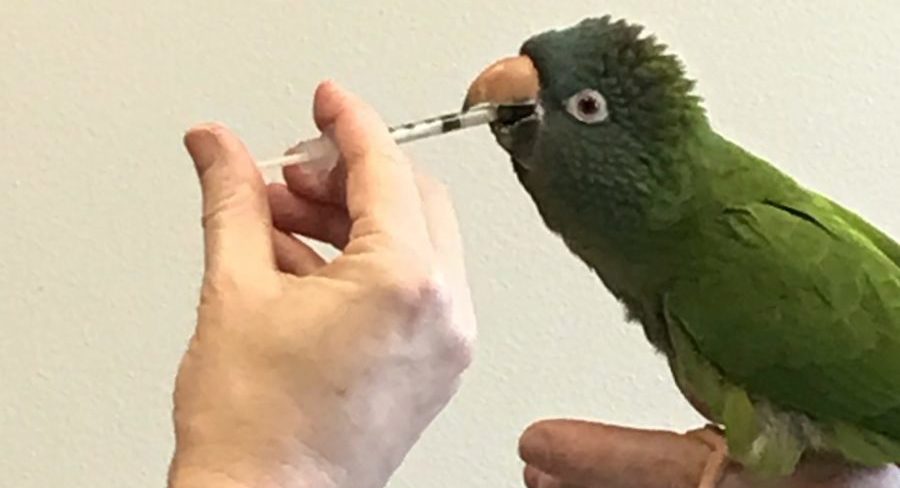Administering medications to birds can be challenging and stressful to everyone involved. For many bird owners, the thought of administering medications brings up images of capturing their frightened or aggressive bird who is rarely handled, wrapping him in a towel, forcing foul-tasting medications into their beak, and possibly getting bitten for their efforts.
Rough handling can severely damage the relationship between bird owners and their feathered companions, which can affect bird and human quality of life in multiple ways. If birds do not receive necessary medications, their health can suffer, and if the human-animal bond is damaged or destroyed, owner and bird no longer interact pleasantly.
The good news is it doesn’t have to be this way! Teaching birds to take medications from a syringe is relatively straightforward. All birds should learn this life skill, as it is likely they will need medications at some point over the course of their life.
Getting Started
Because many parrots are hand fed as babies, it is easy to teach young birds to take liquid medications from a syringe; it is an extension of a behavior that they already know. However, most bird owners delay this type of training until their bird is an adult and faced with a health problem. Thankfully, there are multiple ways to teach adult birds to voluntarily take medications from a syringe.
If the bird is not afraid of syringes and is willing to investigate the tip of the syringe with their beak, you can put a liquid treat such as fruit juice in the syringe – many birds will eagerly take the juice from the syringe. Intermittently, switch out with a less tasty liquid but then follow it up with the tasty juice. As long as the bird knows their favorite treat is going to follow, they will often willingly take the less desirable liquid.
The other common way to train this behavior is through shaping, which is an excellent option for birds who are initially frightened of syringes. Shaping is the process of reinforcing small steps toward a desired behavior. For example, you start rewarding the bird for looking at the syringe when it is still quite a distance from the bird. You want to make sure the syringe is far enough away from the bird to not evoke a fear response.
Appropriate rewards (also known as reinforcers) could be food, desired touch, access to toys, or access to a favorite person – whatever the bird finds appealing. Once the bird is consistently earning desired consequences for looking at the syringe, move the syringe a little closer to the bird (or reward the bird for moving toward the syringe). Continue reinforcing this behavior for a period of time until the bird willingly looks or moves toward the syringe without showing any signs of discomfort.
Moving Forward
Gradually, over time and several training sessions, move the syringe closer and closer to the bird through small approximations. Reward the bird for not showing fear responses. Be careful not to move so quickly that you evoke a fear response. This process is called systematic desensitization and counterconditioning.
Once the syringe is getting close to the bird, carefully and gradually move a food item behind the tip of the syringe, so the bird must move past the syringe to access the food treat. Eventually the bird will bump into the tip of the syringe, either out of curiosity or by accident. Reinforce this heavily, then add it to your criteria for receiving a favorite food item.
When the bird consistently touches the tip of the syringe with the beak, you can put some water or juice in the syringe. Often this means taking several steps back in the shaping process because the syringe looks different. However, it usually takes less time to build back up your criteria than it did originally. Once the bird is reliably touching the tip of the syringe again, you can put a drop of the liquid in the mouth. Many parrots will shake their heads and be startled when this happens for the first time. Pair this with a significant reward. Reduce your criteria again and build back up to the drop of liquid. Then increase your criteria to require multiple drops of liquid to be administered.
If the bird is reliably taking water or juice from a syringe, switch out the liquid for something more bitter, such as dilute apple cider vinegar, and repeat the training process. Always follow accepting fluid from the syringe with some desired reinforcer, such as food (nuts, millet, fruit, juice, etc.), toys, or other pleasant experience.
While this may sound complicated, many bird owners are able to train this behavior in just a few 5- to 15-minute training sessions. Having confidence that they will be able to compassionately and effectively medicate their birds if necessary is a huge relief for them. You can do it, too!








